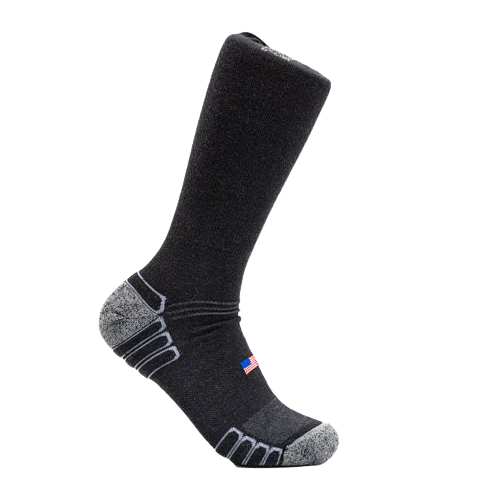The question of whether to get lace up or pull on work boots really depends on what kind of jobs you expect to be working.
Each type of boot has its benefits and its drawbacks. There are certain jobs where you should absolutely get one type over the other.
I’ll try and cover as many scenarios as possible, so you leave knowing the exact type of work boots that’s going to help you get the job done.
The Benefits of Lace Up Boots

Probably the biggest benefit of a lace up boot is that you get the best possible ankle support.
For work boots, I always recommend a style that's at least a 6” in height as that’s going to offer more security for your ankle and keep your heel set back in the boot.
Ariat’s work boots have a ton of shock absorption and I think Ariat is the most comfort-focused work boot brand I’ve ever personally tried.
With a lace up like the Endeavor, the tighter you make the laces, the more ankle support you get.

But a second major benefit of a lace up work boot comes with the fit. Everyone has different shaped feet. And even your two feet can have different shapes (for instance, my right foot has a taller instep than the left, which makes my boots crease differently).
So with laces, you can tighten or loosen certain parts based on your comfort level. You get a much more customized fit in your boots.
And not only that, you can also try several different lacing methods to achieve different levels of security in the various parts of your foot. Opting for quality work socks with padding in the right areas like any of these cuts from Camel City Mill will also always boost your comfort level.
So to summarize, the biggest benefits you get with a lace up boot are:
- Best possible ankle support (this only increases if you get a 6”, 8”, or even 10” boot).
- More flexibility in sizing, which is ideal if you have differently shaped feet, or if your feet tend to swell throughout the work day.
The Benefits of Pull On Work Boots

Pull on work boots are a necessity for many ranch workers. And the reason why is also applicable to a lot of other trades.
If you’re working a ranch, there’s a lot of mud, muck, and debris. If you have lace up boots in that scenario, all that crud will get stuck in the laces and eyelets and be a total mess.
Your life will be much easier with a pull on, which you can just hose off at the end of the day.
Obviously, ranch work isn’t the only kind of dirty work. So if your job has you regularly standing in mud, or really any job where your boots get seriously dirty, then I recommend pull on boots.
A great example is the Ariat Intrepid western style work boot. Unlike a lot of pull on work boots, the Intrepid (and all of Ariat’s work boots to be honest) is really easy to pull on because of their patented U-Turn technology. I once threw out my back putting on a pair of cowboy boots, so this is a special feature to me.
Ariat boots feature what they call a U-Turn Entry technology. It’s a flexible piece of elastic hidden in the back of the shaft, so the opening expands a little as you slip the boots on.

This also makes it more accommodating to people with higher insteps and wider feet.
This essentially makes them as easy to slip on as a pair of Chelsea boots, but they retain all the rugged durability of a traditional work boot.
On the flip side, Ariat boots are also really easy to pull off because of the U-Turn Entry. It might not sound like a major benefit, but anyone with a bad back knows how painful it can be to struggle with a pair of boots.
A lot of guys give up on boots completely because of this. The level of comfort Ariat provides is a major reason I recommend them often for work boots.
To summarize the main benefits of pull on work boots:
- They’re easier to clean, so if you work a dirty job, pull on boots are much better.
- They’re easier to slip on and off, which is great for everyone, but particularly helpful if you struggle with lower back pain.
Drawbacks of Lace Up and Pull On Boots

Laces also undergo wear and tear, so they can start to fray and can snap. If you bust a lace in the middle of the work day, you just end up going around with a floppy boot all day. At best, it’s annoying. At worst, it’s dangerous.
So if you work any job where your boots get dirty often, I’d stick with a pull on.
However, pull on boots aren’t always the best choice for a few reasons. They don’t have as much ankle support, and they tend to have more heel-slip in them, especially when you’re breaking in new boots.
Because the boots feel a bit looser, you might not have the total security needed when you’re climbing a ladder or a pole.
On the flip side, if you size down to compensate for the looser fit, you may end up with pull on boots that feel too tight and crowd your instep. This can just feel uncomfortable and even painful as you go through your day.
Should You Get Lace Up or Pull On Work Boots?

If you’ve read all the above and you’re truly still on the fence, I recommend a lace up work boot like the Ariat Endeavor.
Another good option is the WorkHog XT BOA because provides the customizable and secure fit of a lace-up, but in a pull-on style. It's the best of both worlds.
Ariat says they "dedicated over six years of development and over 12,000 hours of wear-testing in various work environments" on the BOA system and it's the ideal balance. This system adjusts to a wide variety of situations so even if your work requires you to be on all kinds of terrain, you'll still have the right boot for the job.
A pull on work boot needs to fit perfectly to give you the support you need to work difficult jobs. So it’s always better to try those on in person if you can.
If you struggle with lower back pain, I also like pull on work boots---particularly Ariat boots like the Intrepid or WorkHog because they have a piece of elastic in the shaft that makes them really easy to slip on and take off. That way, you don’t have to spend any time hunched over your boots, which can be a major pain.






